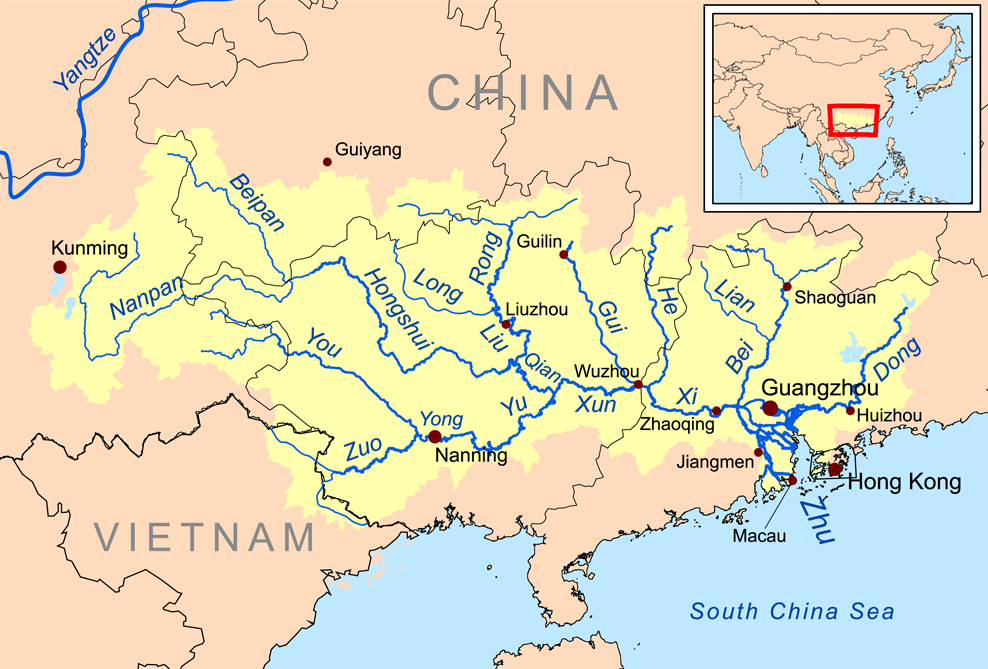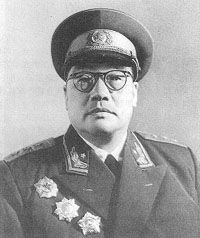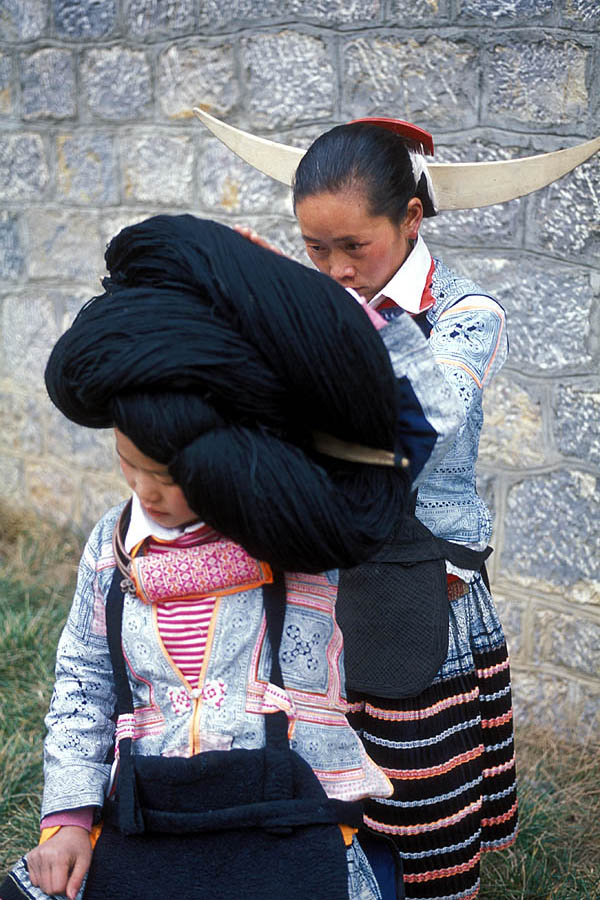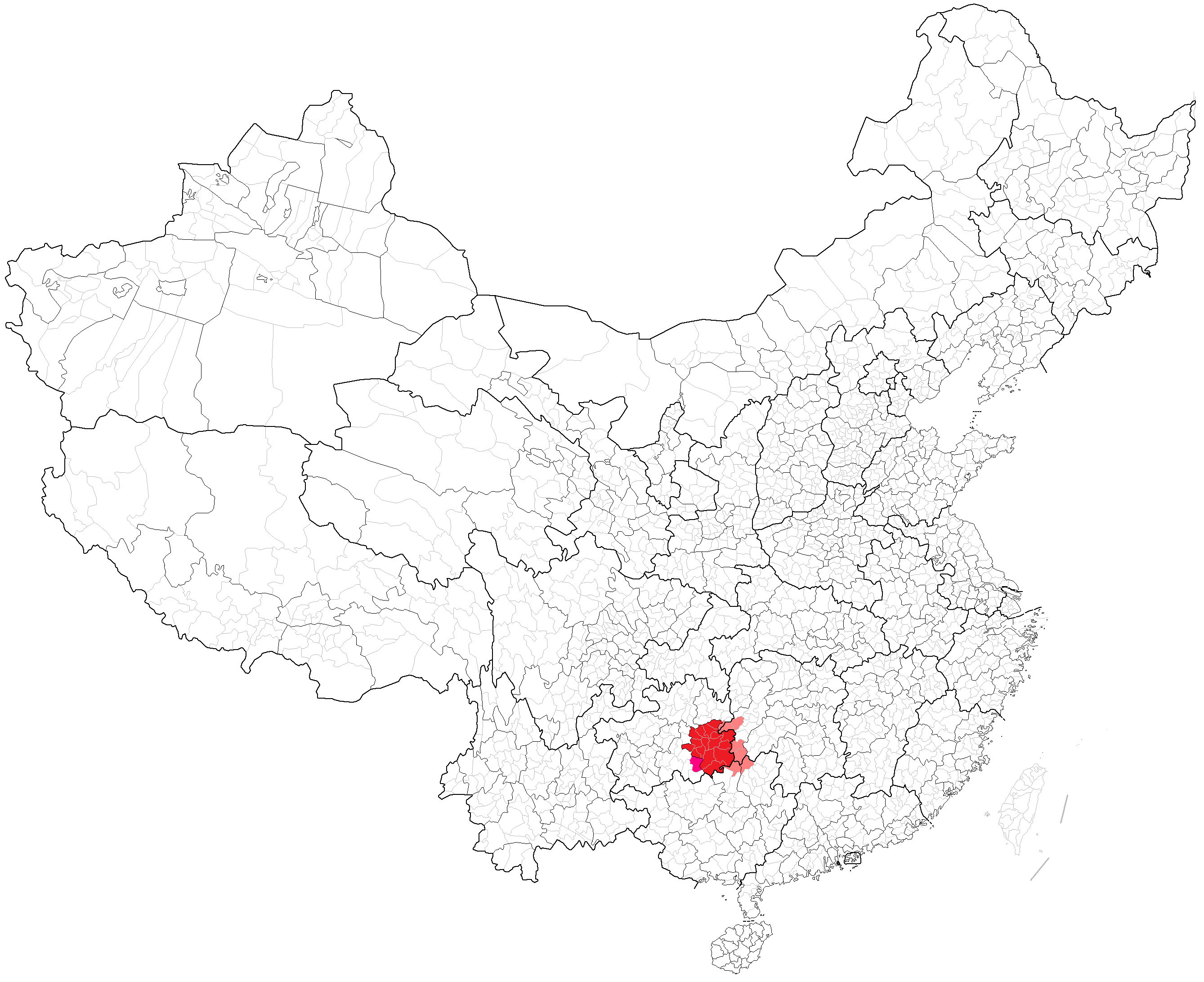|
Guangxi
Guangxi,; officially the Guangxi Zhuang Autonomous Region, is an Autonomous regions of China, autonomous region of the China, People's Republic of China, located in South China and bordering Vietnam (Hà Giang Province, Hà Giang, Cao Bằng Province, Cao Bằng, Lạng Sơn Province, Lạng Sơn, and Quảng Ninh Provinces) and the Gulf of Tonkin. Formerly a Provinces of China, province, Guangxi became an autonomous region in 1958. Its current capital is Nanning. Guangxi's location, in mountainous terrain in the far south of China, has placed it on the frontier of Chinese civilization throughout much of History of China, Chinese history. The current name "Guang" means "expanse" and has been associated with the region since the creation of Guang Prefecture in 226 AD. It was given Administrative divisions of the Yuan dynasty, provincial level status during the Yuan dynasty, but even into the 20th century, it was considered an open, wild territory. The abbreviation of the regi ... [...More Info...] [...Related Items...] OR: [Wikipedia] [Google] [Baidu] |
Zhuang People
The Zhuang (; ; , , Sawndip: 佈獞) are a Tai-speaking ethnic group who mostly live in the Guangxi Zhuang Autonomous Region in Southern China. Some also live in the Yunnan, Guangdong, Guizhou, and Hunan provinces. They form one of the 56 ethnic groups officially recognized by the People's Republic of China. With the Bouyei, Nùng, Tày, and other Northern Tai speakers, they are sometimes known as the Rau or Rao people. Their population, estimated at 18 million people, makes them the largest minority in China. Etymology The Chinese character used for the Zhuang people has changed several times. Their autonym, "Cuengh" in Standard Zhuang, was originally written with the graphic pejorative , (or ''tóng'', referring to a variety of wild dog).漢典.獞. Chinese. Accessed 14 August 2011. 新华字典, via 中华昌龙网. 字典频道.". Chinese. Accessed 14 August 2011. Chinese characters typically combine a semantic element or radical and a phonetic element. John De ... [...More Info...] [...Related Items...] OR: [Wikipedia] [Google] [Baidu] |
Nanning
Nanning; is the capital of the Guangxi, Guangxi Zhuang Autonomous Region in South China, southern China. It is known as the "Green City (绿城) " because of its abundance of lush subtropical foliage. Located in the South of Guangxi, Nanning is surrounded by a hilly basin, with a warm, monsoon-influenced humid subtropical climate. Beginning in 1949, as it underwent sustained industrial growth, Nanning's economy began developing beyond its former role, and the city became essentially a commercial and administrative centre. Today, Nanning is considered the economic, financial and cultural center of Guangxi, and the chief centre for the training of the Zhuang people, Zhuang minority in Guangxi. The People's Park (Nanning), People's Park is located in the center of the city. The city also serves as a gateway for the China-ASEAN opening up and cooperation. As of 2024, Nanning was ranked one of the top 200 List of cities by scientific output, science cities in the world by scientif ... [...More Info...] [...Related Items...] OR: [Wikipedia] [Google] [Baidu] |
Chairman Of Guangxi
The Chairperson of the Guangxi Zhuang Autonomous Region People's Government is the head of the Guangxi, Guangxi Zhuang Autonomous Region and leader of the People's Government of the Guangxi Zhuang Autonomous Region. The chairperson is elected by the People's Congress of the Guangxi Zhuang Autonomous Region, and responsible to it and its Standing Committee. The chairperson is a Civil service of the People's Republic of China, provincial level official and is responsible for the overall decision-making of the regional government. The chairperson is assisted by an executive vice chairperson as well as several vice chairpersons. The chairperson generally serves as the deputy secretary of the Guangxi Zhuang Autonomous Regional Committee of the Chinese Communist Party, Guangxi Zhuang Autonomous Regional Committee of the Chinese Communist Party and as a member of the Central Committee of the Chinese Communist Party, CCP Central Committee. The chairperson the second-highest ranking offici ... [...More Info...] [...Related Items...] OR: [Wikipedia] [Google] [Baidu] |
Yue Chinese
Yue () is a branch of the Sinitic languages primarily spoken in Northern and southern China, Southern China, particularly in the provinces of Guangdong and Guangxi (collectively known as Liangguang). The term Cantonese is often used to refer to the whole branch, but linguists prefer to reserve the name Cantonese for the variety used in Guangzhou (Canton), Wuzhou (Ngchow), Hong Kong and Macau, which is the Prestige (sociolinguistics), prestige dialect of the group. Taishanese, from the coastal area of Jiangmen (Kongmoon) located southwest of Guangzhou, was the language of most of the 19th-century emigrants from Guangdong to Southeast Asia and North America. Most later migrants have been speakers of Cantonese. Yue languages are not Mutual intelligibility, mutually intelligible with each other or with other varieties of Chinese, Chinese languages outside the branch. They are among the most Linguistic conservatism, conservative varieties with regard to the final consonants and to ... [...More Info...] [...Related Items...] OR: [Wikipedia] [Google] [Baidu] |
Yao People
The Yao people () or Dao () is a classification for various ethnic minorities in China and Vietnam. Their majority branch is also known as Mien. They originated in the areas around Changsha, which today is the capital of Hunan province. They speak a branch of the Hmong-Mien family of languages and share a strong genetic connection to the Hmong peoples. They are believed to have diverged from the Hmong around 5,800 years ago. They are one of the 56 officially recognized ethnic groups in China and reside in the mountainous southwest and south of the country. They also form one of the 54 ethnic groups officially recognized by Vietnam. They numbered 2,796,003 in the 2010 Chinese census and 891,151 in the 2019 Vietnamese census. An estimated 60,000 Yao of the Iu Mien branch reside in the United States, mostly in the Western coastal states. History China Origin myth The origins of the Yao can be traced back two millennia to Hunan around the Dongting Lake region. According to ... [...More Info...] [...Related Items...] OR: [Wikipedia] [Google] [Baidu] |
Miao People
Miao is a word that the Chinese use to designate some ethnic minority groups living in southern China and Mainland Southeast Asia. Miao is thus officially recognized by the Chinese government as one of the largest ethnic minority groups that has more than 56 official ethnicities and dialects. The Miao live primarily in the mountains of southern China. Their homeland encompasses the provinces of Guizhou, Yunnan, Sichuan, Hubei, Hunan, Guangxi, Guangdong, and Hainan. Some sub-groups of the Miao, most notably the Hmong people, have migrated out of China into Southeast Asia (Myanmar, Northern Vietnam, Laos, and Thailand). Following the communist takeover of Laos in 1975, a large group of Hmong refugees resettled in several Western nations, mainly in the United States, France, and Australia. Miao is a Chinese term, while the component groups of people have their own autonyms, such as (with some variant spellings) Hmong, Hmu, Xong (Qo-Xiong), and A-Hmao. These people (except th ... [...More Info...] [...Related Items...] OR: [Wikipedia] [Google] [Baidu] |
Pinghua
Pinghua is a pair of Sinitic languages spoken mainly in parts of Guangxi, with some speakers in Hunan. Pinghua is a trade language in some areas of Guangxi, spoken as a second language by speakers of Zhuang languages. Some speakers are officially classified as Zhuang, and many are genetically distinct from most other Han Chinese. The northern subgroup is centered on Guilin and the southern subgroup around Nanning. The Southern dialect has several notable features such as having four distinct checked tones, and using various loanwords from the Zhuang languages, such as the final particle '' wei'' for imperative sentences. History Historically, Pinghua is associated with the earliest Han Chinese migrants who entered Guangxi via Hunan in the 1st millennium AD. The name is said to derive from the Pingnan Jun (平南軍, "Pacify the South Army"), a Northern Song-era army led by Di Qing in the 11th century. Classification Language surveys in Guangxi during the 1950s recorded va ... [...More Info...] [...Related Items...] OR: [Wikipedia] [Google] [Baidu] |
Party Secretary Of Guangxi
The secretary of the Guangxi Zhuang Autonomous Regional Committee of the Chinese Communist Party is the leader of the Guangxi Zhuang Autonomous Regional Committee of the Chinese Communist Party (CCP). As the CCP is the sole ruling party of the People's Republic of China (PRC), the secretary is the highest ranking post in Guangxi. The secretary is officially appointed by the CCP Central Committee based on the recommendation of the CCP Organization Department, which is then approved by the Politburo and its Standing Committee. The secretary can be also appointed by a plenary meeting of the Guangxi Regional Committee, but the candidate must be the same as the one approved by the central government. The secretary leads the Standing Committee of the Guangxi Regional Committee, and is usually a member of the CCP Central Committee. The secretary leads the work of the Regional Committee and its Standing Committee. The secretary is outranks the chairman, who is generally the deputy secre ... [...More Info...] [...Related Items...] OR: [Wikipedia] [Google] [Baidu] |
Dong People
The Kam people ( Kam: , ), officially known in China as Dong people (), are a Kam–Sui people and one of the 56 ethnic groups officially recognized by the People's Republic of China. They live mostly in eastern Guizhou, western Hunan and northern Guangxi. Small pockets of Kam speakers are found in Tuyên Quang Province in Vietnam. They are famed for their native-bred Kam Sweet Rice (), carpentry skills and unique architecture, in particular a form of covered bridge known as the "wind and rain bridge" (). The Kam people call themselves ''Kam'', ''Geml'', ''Jeml'' or ''Gaeml''. History The Kam are thought to be the modern-day descendants of the ancient Rau peoples who occupied much of southern China.D. Norman Geary, Ruth B. Geary, Ou Chaoquan, Long Yaohong, Jiang Daren, Wang Jiying (2003). ''The Kam People of China: Turning Nineteen''. (London / New York, RoutledgeCurzon 2003). . Kam legends generally maintain that the ancestors of the Kam migrated from the east. According to ... [...More Info...] [...Related Items...] OR: [Wikipedia] [Google] [Baidu] |
Han People
The Han Chinese, alternatively the Han people, are an East Asian ethnic group native to Greater China. With a global population of over 1.4 billion, the Han Chinese are the world's largest ethnic group, making up about 17.5% of the world population. The Han Chinese represent 91.11% of the population in China and 97% of the population in Taiwan. Han Chinese are also a significant diasporic group in Southeast Asian countries such as Thailand, Malaysia, and Indonesia. In Singapore, people of Han Chinese or Chinese descent make up around 75% of the country's population. The Han Chinese have exerted a primary formative influence in the development and growth of Chinese civilization. Originating from Zhongyuan, the Han Chinese trace their ancestry to the Huaxia people, a confederation of agricultural tribes that lived along the middle and lower reaches of the Yellow River in the north central plains of China. The Huaxia are the progenitors of Chinese civilization and ancestor ... [...More Info...] [...Related Items...] OR: [Wikipedia] [Google] [Baidu] |
Autonomous Regions Of China
The autonomous regions ( zh, s=自治区, p=Zìzhìqū) are one of four types of province-level divisions of China, province-level divisions of the People's Republic of China. Like provinces of China, Chinese provinces, an autonomous region has its own local government, but under the law of the People's Republic of China, an autonomous region has more legislative rights, such as the right to "formulate self-government regulations and other separate regulations." An autonomous region is the highest level of Autonomous administrative divisions of China, minority autonomous entity in China, which has a comparably higher population of a particular minority ethnic group. There are five autonomous regions in China: Guangxi, Inner Mongolia, Inner Mongolia (Nei Menggu), Ningxia, Tibet Autonomous Region, Tibet (Xizang), and Xinjiang. History Established in 1947, the Inner Mongolia, Inner Mongolia Autonomous Region became the first autonomous region in the Communist-controlled China ... [...More Info...] [...Related Items...] OR: [Wikipedia] [Google] [Baidu] |
Sun Dawei
Sun Dawei (; born April 1963) is a Chinese politician, and current Deputy Communist Party Secretary of the Guangxi Zhuang Autonomous Region. Sun was born in Anda, Heilongjiang. He joined the Chinese Communist Party in December 1984, and is a graduate of the Harbin Engineering University, where he majored in management science and engineering. He began work in July 1986. He began his climb on the bureaucratic ladder initially as the head of the Inspection and Quarantine Bureau in Chaoyang District. He then joined the General Administration of Quality Supervision, Inspection and Quarantine The General Administration of Quality Supervision, Inspection and Quarantine of the People's Republic of China ( zh, 中华人民共和国国家质量监督检验检疫总局, abbreviated AQSIQ) was a ministerial-level department under the State ... as a deputy head, then head, of the inspection supervision department (). He was then named executive deputy chair of the Certification and Acc ... [...More Info...] [...Related Items...] OR: [Wikipedia] [Google] [Baidu] |







